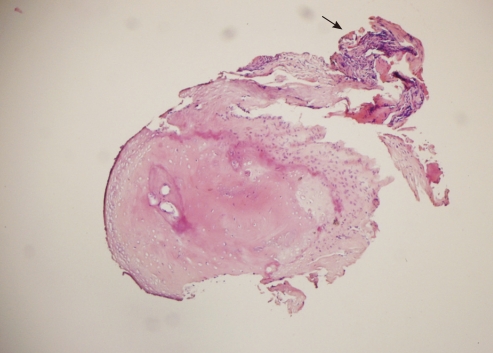Clin Exp Otorhinolaryngol.
2011 Mar;4(1):24-26.
Shall We Resect the Tip of Manubrium Mallei in Tympanoplasty?
- Affiliations
-
- 1Department of ENT, Ankara Ataturk Training and Research Hospital, Ankara, Turkey. gkhnyalciner@yahoo.com
- 2Department of Pathology, Ankara Ataturk Training and Research Hospital, Ankara, Turkey.
Abstract
OBJECTIVES
In tympanoplasty operations if perforation is related with malleus handle, malleus handle is desepithelised. We planned this research to investigate whether the epithelial remnants remain as a result of this desepithelisation or not.
METHODS
The 35 patients who were performed tympanoplasty operation were divided into two groups. In the first group which included 13 patients the tip portion of manubrium mallei were cut off without desepithelisation. In the second group which included 22 patients the tip portions of manubrium mallei were cut off after the meticulous desepithelisation. The presence of squamous epithelium was examined histopathologically on the specimens.
RESULTS
Squamous epithelium was observed in 9 of the 13 non-desepithelised specimens and in 6 of 22 desepithelised specimens.
CONCLUSION
In tympanoplasty operations despite careful desepithelisation, squamous epithelial remnants may remain on the malleus handle. So the tip of manubrium mallei could be resected to prevent the future development of cholesteatoma.
Figure
Reference
-
1. Wehrs RE. Grafting techniques. Otolaryngol Clin North Am. 1999; 6. 32(3):443–455. PMID: 10393778.
Article2. Tos M. Manual of middle ear surgery. 1993. New York: Thieme Medical Publishers.3. Angeli SI, Kulak JL, Guzmán J. Lateral tympanoplasty for total or near-total perforation: prognostic factors. Laryngoscope. 2006; 9. 116(9):1594–1599. PMID: 16954986.
Article4. Sheehy JL, Anderson RG. Myringoplasty: a review of 472 cases. Ann Otol Rhinol Laryngol. 1980; Jul–Aug. 89(4 Pt 1):331–334. PMID: 7416683.5. Albu S, Babighian G, Trabalzini F. Prognostic factors in tympanoplasty. Am J Otol. 1998; 3. 19(2):136–140. PMID: 9520047.6. Graham MD, Reams C, Perkins R. Human tympanic membrane-malleus attachment: preliminary study. Ann Otol Rhinol Laryngol. 1978; May–Jun. 87(3 Pt 1):426–431. PMID: 655586.7. Nejadkazem M, Totonchi J, Naderpour M, Lenarz M. Intratympanic membrane cholesteatoma after tympanoplasty with the underlay technique. Arch Otolaryngol Head Neck Surg. 2008; 5. 134(5):501–502. PMID: 18490571.
Article8. Goldenberg RA. Hydroxylapatite ossicular replacement prostheses: preliminary results. Laryngoscope. 1990; 7. 100(7):693–700. PMID: 2163478.9. Brackmann DE, Sheehy JL, Luxford WM. TORPs and PORPs in tympanoplasty: a review of 1042 operations. Otolaryngol Head Neck Surg. 1984; 2. 92(1):32–37. PMID: 6422413.
Article10. Herman P, Wassef M, Huy PT. Mallear epidermosis: an unusual form of open mucous otitis. Ann Otolaryngol Chir Cervicofac. 1998; 11. 115(5):271–278. PMID: 9881174.
- Full Text Links
- Actions
-
Cited
- CITED
-
- Close
- Share
- Similar articles
-
- A Case of Developmental Anomaly of the Process of Folius Associated with Conductive Hearing Loss
- Variations of the Technique in Endoscopic Tympanoplasty
- A Case of Cutaneo - Visceral Hemangioma with Absence of Manubrium Sterni - Gorham' s Disease
- Microscopic versus Endoscopic Inlay Butterfly Cartilage Tympanoplasty
- Change of bone conduction threshold in successful tympanoplasty



